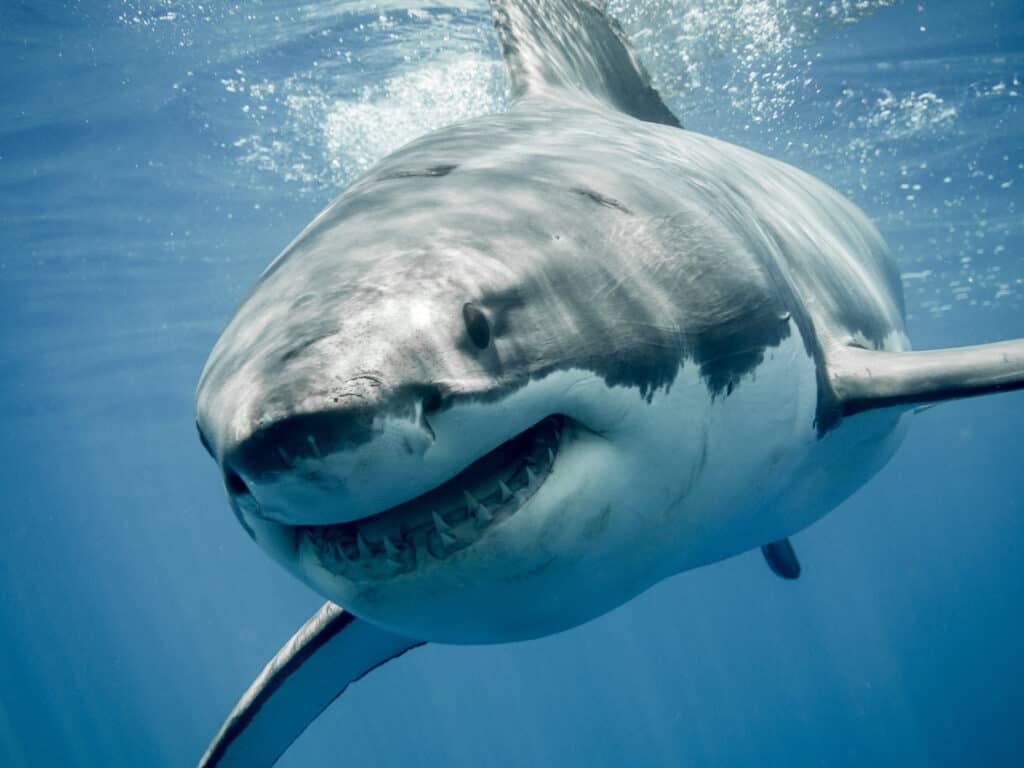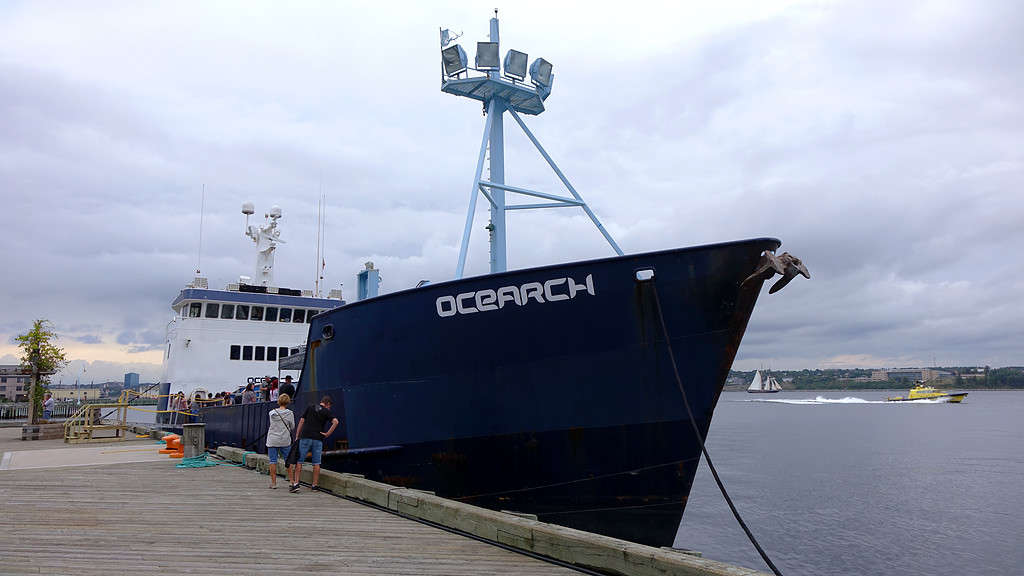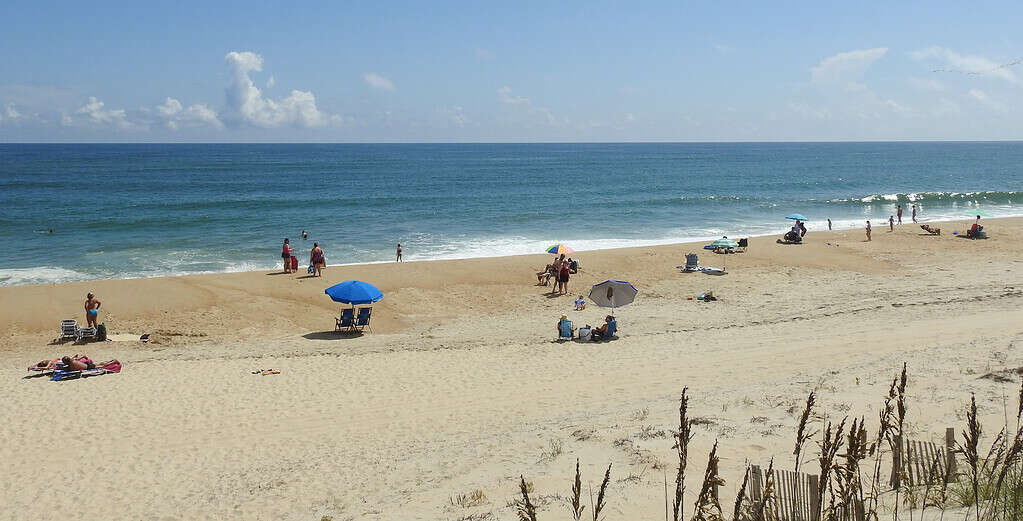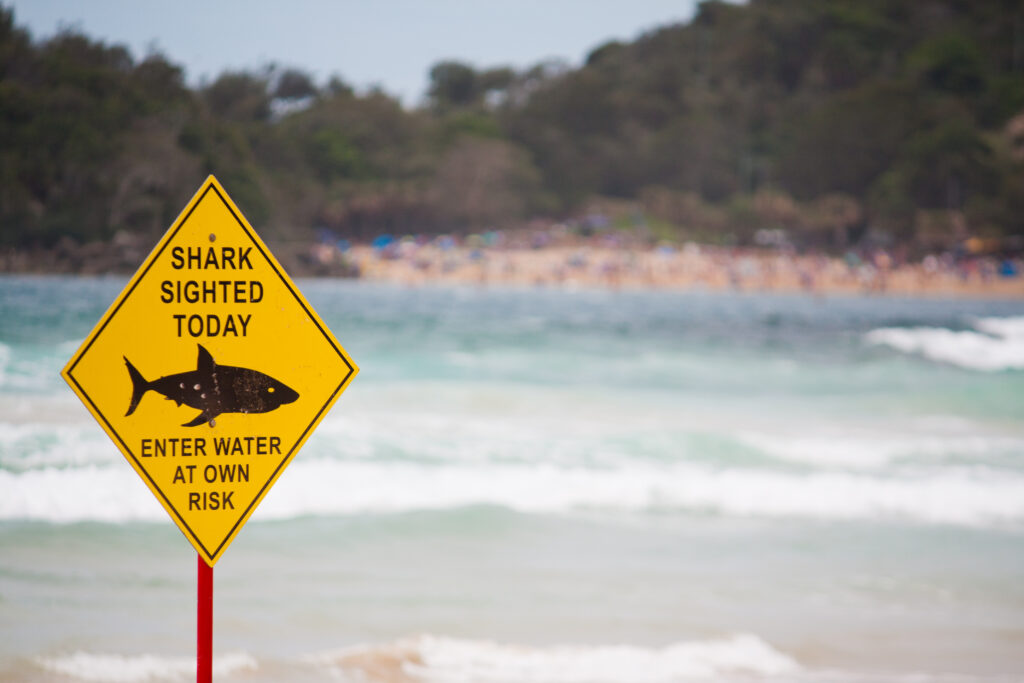This spring has been an especially active season for sharks in the waters off of North Carolina’s Outer Banks, and that doesn’t appear to be changing any time soon. A 1,500-pound great white shark just showed up near a public beach on Bodie Island, just a few miles south of Nags Head.
Breton
The shark’s name is Breton. While wild sharks generally don’t have names, the ones tagged by OCEARCH do. The global non-profit organization is dedicated to studying the apex predators of the ocean and educating the public about their importance. OCEARCH tags and tracks sharks to learn more about their movements, behavior patterns, and more. The organization just completed its 45th expedition, where four more sharks were sampled and tagged.

A large great white shark is swimming in the waters near an Outer Banks beach.
©Ramon Carretero/Shutterstock.com
Breton was tagged on September 12, 2020, off of Scatarie Island in Nova Scotia. Since then, Breton has logged over 24,700 miles of Atlantic Ocean water, showing up as far north as the Honguedo Strait in Quebec and as far south as the Turks and Caicos Islands. But one of his favorite haunts seems to be the Carolinas.
Sharks often congregate off of North and South Carolina in February. OCEARCH theorizes that it may be a breeding ground and nursery for great whites, although that has yet to be definitively proven. The evidence does seem to point in that direction, though.
However, May is often the time that the sharks begin making their way further north. As waters warm, these sharks typically move north to New England and Canada. Breton, however, seems quite content to remain in North Carolina waters. The tracking data shows the shark has spent much of May in the Outer Banks.
Tracking Sharks
When OCEARCH tags a shark, a transmitter is affixed to the shark’s dorsal fin. There is ample evidence that the transmitter has no effect on the shark’s normal movement and behavior.
For researchers to pinpoint a tagged shark’s location, the shark must swim to the surface. Once the transmitter breaks the water’s surface, a ping is sent to OCEARCH. The shark must cruise at the surface for at least 90 seconds for researchers to determine its location. If the shark dives before the 90 seconds are up, a Z-ping is recorded. Z-pings show that the shark surfaced, but it doesn’t provide enough data for geolocation.
Some sharks show up on OCEARCH’s tracker all the time, while others are rare, seeming to prefer to remain in the depths. Breton is one of the largest sharks that shows up consistently in the tracking data. And, for reasons not yet fully known, that data shows that Breton loves hanging out in the Carolinas.

OCEARCH expeditions are vital to increasing our understanding of great white sharks.
©Coastal Elite from Halifax, Canada / CC BY-SA 2.0 – License
Staying Shark-Safe
Breton is swimming in North Carolina waters at a time when the beaches are full. The weather has warmed. Schools are preparing for summer break. There is no doubt that it is beach time on the Outer Banks, but how do beachgoers stay safe when there is a 1,500-pound great white nearby?

The beaches of the Outer Banks are amazing, as long as beachgoers take the needed steps to stay safe.
©SherryLee/Shutterstock.com
There are measures that swimmers can take to greatly lessen the odds of a shark encounter. Here is a checklist to help you stay safe at the beach.
- Don’t swim alone. By swimming in a group, you are far less likely to encounter a shark than if you were swimming alone.
- Remove all jewelry and avoid shiny swimsuits. Sharks have fairly poor eyesight. When the sun flashes off of a shiny object, the shark could possibly interpret it as the flash of a fish’s fins and move closer to investigate or even bite at the flashy object.
- Stay away from anyone who is fishing. The bait or lures that anglers use could potentially attract sharks into the area.
- Remain in shallow water. The further you move from shore, the greater your chances of a shark encounter.
- Pay attention to local reports. If a beach reports increased shark activity, stay out of the water.
- Never harass a shark. You would think that would go without saying, but sometimes shark attacks happen because the shark was provoked. Harassing these apex predators is dangerous and supremely stupid.

Pay attention to local reports on shark activity.
©iStock.com/mingis
Shark Attacks: Rare, But Not Impossible
It is important to note that shark attacks are very rare. Even with all the increased shark activity in 2023, there has not been a single shark bite reported in North Carolina. Still, we know that sharks are swimming these waters in greater numbers, thanks in large part to OCEARCH’s research. While there is no need to fear, there is every need to take precautions so a day of fun at North Carolina’s stunning beaches doesn’t take a tragic turn.
The photo featured at the top of this post is © Sergey Uryadnikov/Shutterstock.com
Thank you for reading! Have some feedback for us? Contact the AZ Animals editorial team.






